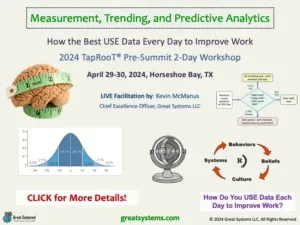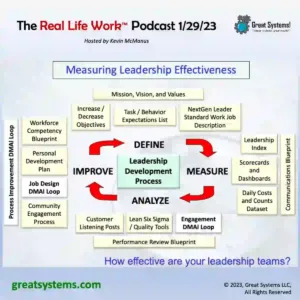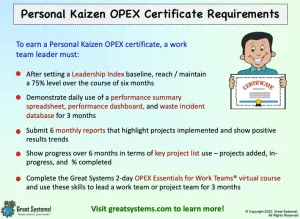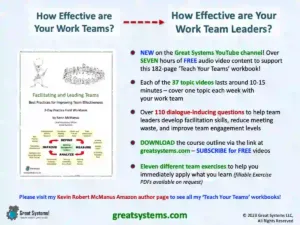How do you measure and improve your leadership work system?
Measure and Improve Your Leadership Work System
Unfortunately, too many organizations only look at output results to determine leader effectiveness. All too often, excellent team members provide cover for poor leadership. On this page, I share ten proven best practices to help your measure and improve your leadership work system. Key leadership work system elements include the formal leadership development process, stakeholder engagement blueprint, and Leader Standard Work plans.
Effective leadership skills come naturally to some people (they are born with these skills). However, many more people with leadership responsibilities exist versus the number of people who were born with these skills. Additionally, few people train to be effective leaders as part of their formal education. If you consider these facts as a set, you see our ineffective leadership roots.
How do you measure and improve your leadership work system?
Whether we want to admit it or not, most leaders lead like parents. This is the leadership model we demonstrate the most often. Also, it is the one that we are most familiar with. Unfortunately, a parental leadership approach does not lead to sustainable, high performance results. How effective are your work team leaders?
Too many workplaces have a high percentage of ineffective leaders in place. It is a harsh reality that we are hesitant to admit. We pay these people significant amounts of money in many cases to be ineffective. Our leadership work systems are to blame.
EXPLORE MORE: How Does Your Work Team Structure Drive Operational Excellence?
Do You Want to Achieve Higher Levels of Leadership Effectiveness?
If you want better leadership results, you have to change your leadership work system. Fortunately, there are a few organizations out there who know this. They design their leadership work system to produce the results they desire.
This work system helps leaders communicate a consistent mission and vision across the organization. It helps each of their leaders develop key skills over time. You cannot improve leadership effectiveness by simply sending your leaders to workshops or asking them to change.
Change the design of the in-place leadership work system if you want better results. What percentage of your work team leaders are effective leaders? How do you know? Does your leadership work system need improvement?
LEARN MORE: Buy my “Facilitating and Leading Teams” workshop workbook on Amazon.com!
Top 10 Leadership Work System Design Flaws
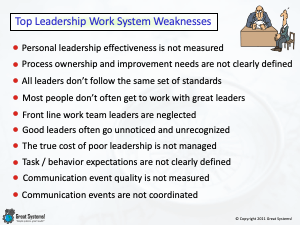
How value added are your leaders?
For years, we have used tools and concepts such as lean thinking and six sigma to take the waste out of our front-line work systems. However, we neglect to use these tools on perhaps the most important, and costly, system in our organizations – the leadership work system.
Think about it. How much does your organization pay out in leadership wages and benefits each day? Do you get value from what EACH of your directors, managers, and supervisors costs? If your leaders stopped spending time on what they spend time on each day, would your customers notice?
High performance organizations, such as those that pursue the Malcolm Baldrige National Quality Award, make an effort to get high amounts of value from each of their leaders. They measure leadership effectiveness on a regular basis, at all levels of the business.
Also, it is an expectation that each leader develops over time. They consistently evaluate the effectiveness of the various types of communication that leaders have with their people, both in meetings and on the job.
Most organizations do not consistently evaluate their leaders, beyond the use of the traditional job description and annual performance appraisal. They may use a 360-degree feedback tool on occasion. However, few companies link the use of this tool to their leadership development process (if a formally defined process exists).
Why do we not search for (demand more) measurable leadership performance? Why are we content to assume that the monthly departmental numbers each leader is responsible for gives us enough feedback to determine if a leader actually does their job or not?
How high are your ‘Leader Standard Waste’ levels?
Do your leaders send a consistent message about performance expectations on the job each day? Do they behave in a manner that is consistent with the organizational culture you desire? How often is their daily time spent on activities that benefit the company the most?
It is likely your responses reflect inconsistency. All too often, we have too much Leader Standard Waste in our organizations. In other words, the daily work habits of our leaders fail to support the mission, vision, and values of the organization. Their daily behaviors are often inconsistent with the organizational roadmap that exists.
We would like to think that the strategic plan we give out each year provides enough leadership guidance. Our monthly meetings should tell everyone where we want to go, and why. Unfortunately, each leader’s daily behavior on the job almost always overrides the contents of a plan or the message leaders state in a meeting. When inconsistent Leader Standard Work practices exist, so does the potential for hypocrisy. Such hypocrisy affects personal performance contributions at all levels in the organization.
How do you define, measure, and improve Leader Standard Work?
Most organizations do not have a formal approach to define, measure, and improve daily Leader Standard Work. This can result in consistent daily levels of Leader Standard Waste. This waste can be of both a behavior and a time nature.
For example, many leaders act one way when their boss is around. Then, they act totally different when they think no one above them is watching. Other simply spend their time on non-value added work.
Either result can have a negative impact on team morale, focus, and performance. A failure to define, measurement, and improve Leader Standard Work can do a lot of damage to an organization in a short amount of time.
What kind of direction do your leaders give to their people each day, both intentional and unintentional? How do you define Leader Standard Work?
Would you benefit from a more effective approach to leadership?
Over the years, I have learned that the work team leader is the key leverage point to make any improvement effort work. These people help execute the organization’s plans every day. Unfortunately, on too many occasions I see how most businesses, schools, and hospitals tend to discount, if not completely ignore, the effectiveness of these people.
For example, rarely do they participate in planning efforts, development activities, or good performance feedback processes. We fail to include those who really make the most difference, good or bad!
How do we solve this problem? How do we make sure that all of our work leaders act and perform in a manner that is consistent with what we want to be and where we want to go? The answers are simple. However, we must let go of some deeply entrenched belief systems. Beliefs drive personal behavior on the job. In turn, they affect plan execution and systems design.
DISCOVER MORE: Ten Ways To Change Work Culture
How consistently do your leaders lead?
What is the greatest failure of most organizations, outside of neglecting work team leaders in general? It lies in our failure to ensure that our leaders consistently practice effective daily work habits. Plus, we want to ensure that key skills exist, or are being developed, as time goes by. For example, how many of your leaders continue to improve their computer skills to keep pace with technology shifts?
How do you ensure that each leader maintains a consistent focus on the needs of both your internal and external customers? Also, how do you make sure that each person you pay to be a leader consistently treats each of their people with respect and dignity? Do your leaders work to build stronger personal relationships with those people they depend on to get the job done each day?
If you have interest in the leadership systems and improvement tools that I have to offer, send me an e-mail at kevin@greatsystems.com.
Top 10 Leadership Work System IMPROVEMENTS
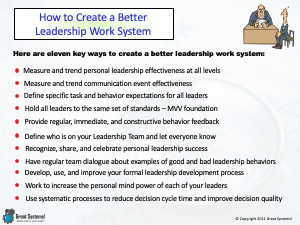
How can we monitor the performance of supervision to help ensure they effectively support the leadership work system?
As with any type of supervision or process ownership, use a balanced set of metrics and reports to track leadership behavior and task effectiveness. For example, you could conduct a ‘bottom up’ Leadership Index for each work team leader by his direct reports at least once a year as a behavior effectiveness metric. Also, hold each work team leader responsible for the safety, cost, quality, and people metrics that his or her processes produce over time (in the form of trend lines and a balanced scorecard).
The impact of work system changes and team development activities should be evident in the process trends. A key mistake most organizations make occurs when we expect an external department, such as Safety, Quality, Engineering, or Human Resources, to manage the process results in these areas across multiple process groups.
How can we monitor daily work team leader performance?
As a plant manager, I expect each of my process owners (and myself) to provide four things each month. First, each process owns keeps a key project list for their processes. Second, they list a monthly summary of their key accomplishments and challenges. The third item is a performance summary spreadsheet that shows DAILY process inputs and outputs. I expected my supervisors to spend 30-60 minutes a day on these items.
Since they use a spreadsheet to compile and organize them, I can review their progress at any time. I simply look at the spreadsheet itself, the results trend lines posted in their process areas, and/or their hard copy monthly report (or intranet web page). My “Personal Kaizen Operational Excellence” certificate process is specifically designed to help you install a similar process for your work team leaders in your organization.
How can Great Systems help you improve your leadership work system?
For over 40 years, I have helped design leadership systems in a variety of organization types, both small and large. These experiences help me discover value added, simple ways to set up systems to measure leadership effectiveness. Plus, they help me link the results of this regular measurement to a formal leadership development process. This helps make sure that all leadership communications are both coordinated and value added.
‘Leader Standard Waste’ is the primary power restrictor for this power system. These tools help you eliminate that waste. Also, they help you move more rapidly forward towards higher levels of performance.
Keep improving!
Kevin McManus, Chief Excellence Officer, Great Systems
WATCH over 50 kaizen and workplace health improvement videos on my Great Systems YouTube channel.
CHECK OUT my ‘Teach Your Teams’ workbooks on Amazon.com
LIKE Great Systems on Facebook
© Copyright 2024, Great Systems LLC, All Rights Reserved
